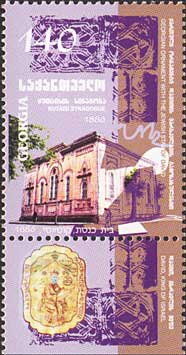Stamp with Attached Label: Kutaisi Synagogue (1886) (Georgia 2001)
Kutaisi Synagogue (1886) (Georgia 2001)
13 September (Georgia ) within release Joint Issue - Georgia and Israel - Kutaisi Synagogue goes into circulation Stamp with Attached Label Kutaisi Synagogue (1886) face value 140 Georgian tetri
| Stamp with Attached Label Kutaisi Synagogue (1886) in catalogues | |
|---|---|
| Michel: | Mi: GE 378uB |
Stamp with Attached Label is vertical format.
Issued in sheets of 20 (5 x 4) - 15 stamps and 5 labels. Joint issue - Georgia and Israel. Israel Mi:IL 1640.Stamp with Attached Label Kutaisi Synagogue (1886) it reflects the thematic directions:
Architecture (Latin architectura, from the Greek ἀρχιτέκτων arkhitekton "architect", from ἀρχι- "chief" and τέκτων "builder") is both the process and the product of planning, designing, and constructing buildings and other physical structures. Architectural works, in the material form of buildings, are often perceived as cultural symbols and as works of art. Historical civilizations are often identified with their surviving architectural achievements.
A joint issue is the release of stamps or postal stationery by two or more countries to commemorate the same topic, event or person. Joint issues typically have the same first day of issue and their design is often similar or identical, except for the identification of country and value.Religion is any cultural system of designated behaviors and practices, world views, texts, sanctified places, ethics, or organizations, that relate humanity to the supernatural or transcendental. Religions relate humanity to what anthropologist Clifford Geertz has referred to as a cosmic "order of existence". Different religions may or may not contain various elements ranging from the "divine", "sacred things", "faith", a "supernatural being or supernatural beings" or "some sort of ultimacy and transcendence that will provide norms and power for the rest of life". Religious practices may include rituals, sermons, commemoration or veneration (of deities), sacrifices, festivals, feasts, trances, initiations, funerary services, matrimonial services, meditation, prayer, music, art, dance, public service, or other aspects of human culture. Religions have sacred histories and narratives, which may be preserved in sacred scriptures, and symbols and holy places, that aim mostly to give a meaning to life. Religions may contain symbolic stories, which are sometimes said by followers to be true, that have the side purpose of explaining the origin of life, the Universe and other things. Traditionally, faith, in addition to reason, has been considered a source of religious beliefs. There are an estimated 10,000 distinct religions worldwide. About 84% of the world's population is affiliated with one of the five largest religions, namely Christianity, Islam, Hinduism, Buddhism or forms of folk religion.



